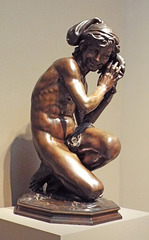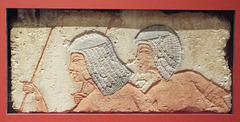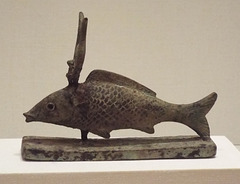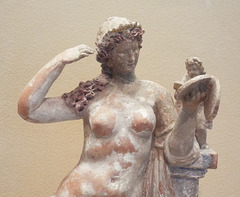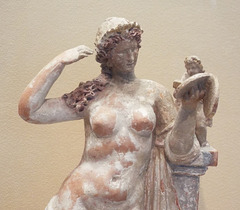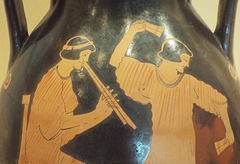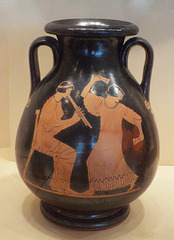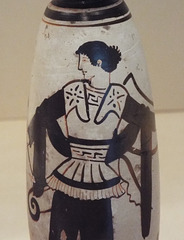
Virginia Museum of Fine Arts
Neapolitan Fisher Boy by Carpeaux in the Virginia…
| |
|
Neapolitan Fisher Boy (Primary Title)
Jean-Baptiste Carpeaux, French, 1827 - 1875 (Artist)
Date: 1873
Culture: French
Category: Sculpture
Medium: bronze
Collection: European Art
Dimensions: Overall (statue): 35 1/4 × 16 × 19 1/4 in. (89.54 × 40.64 × 48.9 cm)
Overall (stand): 41 × 16 × 19 in. (104.14 × 40.64 × 48.26 cm)
Object Number: 60.17
Contemporary Italian subjects were extremely popular in 19th-century Europe, as they offered an opportunity for cultural fantasies concerning urbanism and modernity. In the wake of the Industrial Revolution, France and other countries experienced cultural shifts in which their urban populations grew while their rural populations decreased. With these shifts emerged a growing fascination with “primitive” and rustic cultures, untainted by the concerns of modern life. As the French in particular grew to define themselves as an industrial society, they needed to create a cultural foil or contrast to their modernity. Italian subjects such as that seen in Carpeaux’s Neapolitan Fisher Boy were embraced for this reason. Case in bronze, Carpeaux’s youthful male figure is nude, placing him in a state of nature. As he kneels on one knee, he holds a shell up to his left ear, carefully balancing himself as he listens. He seems unaware of his nudity and captivated by the sensory and sensual experience of listening to the shell. Carpeaux studied at the French Academy in Rome in the 1850s and ‘60s, and claimed to have based this figure on a youth he observed in Naples. Because it captures a spontaneous and dynamic moment of human activity, the post of the youth is typical of Carpeaux’s work because it captures a spontaneous and dynamic moment of human activity.
Text from: www.vmfa.museum/piction/7898249-174292293
Egyptian Relief with Two Royal Attendants in the V…
| |
|
Two Royal Attendants (Primary Title)
Unknown (Artist)
Date: 1365-1345 B.C.
Culture: Egyptian
Category: Sculpture
Medium:limestone, pigment modern?
Collection: Ancient Art
Geography: Egypt
Dimensions: Overall: 9 × 19 1/2 × 1 1/2 in. (22.86 × 49.53 × 3.81 cm)
Object Number: 61.5
Text from: www.vmfa.museum/piction/6027262-121933790
Egyptian Relief with Two Royal Attendants in the V…
| |
|
Two Royal Attendants (Primary Title)
Unknown (Artist)
Date: 1365-1345 B.C.
Culture: Egyptian
Category: Sculpture
Medium:limestone, pigment modern?
Collection: Ancient Art
Geography: Egypt
Dimensions: Overall: 9 × 19 1/2 × 1 1/2 in. (22.86 × 49.53 × 3.81 cm)
Object Number: 61.5
Text from: www.vmfa.museum/piction/6027262-121933790
Sacred Fish with the Crown of Isis in the Virginia…
| |
|
|
Sacred Fish with a Crown of Isis (Primary Title)
Unknown (Artist)
Date: 664-332 BC
Culture: Egyptian
Category: Sculpture
Medium: bronze, glass
Collection: Ancient Art
Dimensions: Overall: 5 1/8 × 7 × 2 in. (13.02 × 17.78 × 5.08 cm)
Object Number: 2001.247
Glass eyes enliven this fish, which also wears the Isis crown-a sun-disc between the horns of a bull. According to myth, the divine brothers Osiris and Seth struggled for control of Egypt. After defeating Osiris, Seth scattered his body parts throughout the land. Isis, Osiris’s wife, gathered the pieces for burial. She found his penis inside a fish, which she honored by declaring it sacred and forbidding anyone to eat it.
Text from: www.vmfa.museum/piction/6027262-7903463
Sacred Fish with the Crown of Isis in the Virginia…
| |
|
Sacred Fish with a Crown of Isis (Primary Title)
Unknown (Artist)
Date: 664-332 BC
Culture: Egyptian
Category: Sculpture
Medium: bronze, glass
Collection: Ancient Art
Dimensions: Overall: 5 1/8 × 7 × 2 in. (13.02 × 17.78 × 5.08 cm)
Object Number: 2001.247
Glass eyes enliven this fish, which also wears the Isis crown-a sun-disc between the horns of a bull. According to myth, the divine brothers Osiris and Seth struggled for control of Egypt. After defeating Osiris, Seth scattered his body parts throughout the land. Isis, Osiris’s wife, gathered the pieces for burial. She found his penis inside a fish, which she honored by declaring it sacred and forbidding anyone to eat it.
Text from: www.vmfa.museum/piction/6027262-7903463
Detail of a Terracotta Statuette of Aphrodite and…
| |
|
Aphrodite and Eros (Primary Title)
Unknown (Artist)
Date: ca. 120 BC
Culture: Greek (Myrina)
Category: Sculpture
Medium: terracotta, traces of pigment
Collection: Ancient Art
Dimensions: Overall: 13 3/4 × 6 3/8 × 3 3/4 in. (34.93 × 16.19 × 9.53 cm)
Object Number: 83.64
Prior to the Hellenistic period, females (unlike males) were rarely depicted nude. Like many of the early images of nude women, this statuette shows Aphrodite, in this case seminude. Here, the goddess of love gazes into a mirror as she adjusts her hair, and her son, Eros, holds a cosmetic box. Such complicated terracottas were made from molds; the cast pieces were assembled and painted with the bright colors used to ornament stone and terracotta statues in antiquity.
Text from: www.vmfa.museum/piction/6027262-107883854
Detail of a Terracotta Statuette of Aphrodite and…
| |
|
Aphrodite and Eros (Primary Title)
Unknown (Artist)
Date: ca. 120 BC
Culture: Greek (Myrina)
Category: Sculpture
Medium: terracotta, traces of pigment
Collection: Ancient Art
Dimensions: Overall: 13 3/4 × 6 3/8 × 3 3/4 in. (34.93 × 16.19 × 9.53 cm)
Object Number: 83.64
Prior to the Hellenistic period, females (unlike males) were rarely depicted nude. Like many of the early images of nude women, this statuette shows Aphrodite, in this case seminude. Here, the goddess of love gazes into a mirror as she adjusts her hair, and her son, Eros, holds a cosmetic box. Such complicated terracottas were made from molds; the cast pieces were assembled and painted with the bright colors used to ornament stone and terracotta statues in antiquity.
Text from: www.vmfa.museum/piction/6027262-107883854
Terracotta Statuette of Aphrodite and Eros in the…
| |
|
Aphrodite and Eros (Primary Title)
Unknown (Artist)
Date: ca. 120 BC
Culture: Greek (Myrina)
Category: Sculpture
Medium: terracotta, traces of pigment
Collection: Ancient Art
Dimensions: Overall: 13 3/4 × 6 3/8 × 3 3/4 in. (34.93 × 16.19 × 9.53 cm)
Object Number: 83.64
Prior to the Hellenistic period, females (unlike males) were rarely depicted nude. Like many of the early images of nude women, this statuette shows Aphrodite, in this case seminude. Here, the goddess of love gazes into a mirror as she adjusts her hair, and her son, Eros, holds a cosmetic box. Such complicated terracottas were made from molds; the cast pieces were assembled and painted with the bright colors used to ornament stone and terracotta statues in antiquity.
Text from: www.vmfa.museum/piction/6027262-107883854
Terracotta Statuette of Aphrodite and Eros in the…
| |
|
Aphrodite and Eros (Primary Title)
Unknown (Artist)
Date: ca. 120 BC
Culture: Greek (Myrina)
Category: Sculpture
Medium: terracotta, traces of pigment
Collection: Ancient Art
Dimensions: Overall: 13 3/4 × 6 3/8 × 3 3/4 in. (34.93 × 16.19 × 9.53 cm)
Object Number: 83.64
Prior to the Hellenistic period, females (unlike males) were rarely depicted nude. Like many of the early images of nude women, this statuette shows Aphrodite, in this case seminude. Here, the goddess of love gazes into a mirror as she adjusts her hair, and her son, Eros, holds a cosmetic box. Such complicated terracottas were made from molds; the cast pieces were assembled and painted with the bright colors used to ornament stone and terracotta statues in antiquity.
Text from: www.vmfa.museum/piction/6027262-107883854
Detail of a Red-Figure Pelike Attributed to the Eu…
| |
|
Red-Figure Pelike (Storage Vessel) (Primary Title)
attributed to, Eucharides Painter (Artist)
Date: ca. 480 BC
Culture: Greek (Attic)
Category: Containers-Vessels
Ceramics
Medium: terracotta
Collection: Ancient Art
Geography: Attica, Greece
Dimensions: Overall: 14 × 10 3/8 in. (35.56 × 26.35 cm)
Object Number: 62.1.13
Music and dance were central to ancient life whether in civic and religious festivals or in private gatherings. Often the women who engaged in these activities were hetairai (courtesans) who provided entertainment at symposia.
Text from: www.vmfa.museum/piction/6027262-8070290
Detail of a Red-Figure Pelike Attributed to the Eu…
| |
|
Red-Figure Pelike (Storage Vessel) (Primary Title)
attributed to, Eucharides Painter (Artist)
Date: ca. 480 BC
Culture: Greek (Attic)
Category: Containers-Vessels
Ceramics
Medium: terracotta
Collection: Ancient Art
Geography: Attica, Greece
Dimensions: Overall: 14 × 10 3/8 in. (35.56 × 26.35 cm)
Object Number: 62.1.13
Music and dance were central to ancient life whether in civic and religious festivals or in private gatherings. Often the women who engaged in these activities were hetairai (courtesans) who provided entertainment at symposia.
Text from: www.vmfa.museum/piction/6027262-8070290
Red-Figure Pelike Attributed to the Eucharides Pai…
| |
|
Red-Figure Pelike (Storage Vessel) (Primary Title)
attributed to, Eucharides Painter (Artist)
Date: ca. 480 BC
Culture: Greek (Attic)
Category: Containers-Vessels
Ceramics
Medium: terracotta
Collection: Ancient Art
Geography: Attica, Greece
Dimensions: Overall: 14 × 10 3/8 in. (35.56 × 26.35 cm)
Object Number: 62.1.13
Music and dance were central to ancient life whether in civic and religious festivals or in private gatherings. Often the women who engaged in these activities were hetairai (courtesans) who provided entertainment at symposia.
Text from: www.vmfa.museum/piction/6027262-8070290
Red-Figure Pelike Attributed to the Eucharides Pai…
| |
|
Red-Figure Pelike (Storage Vessel) (Primary Title)
attributed to, Eucharides Painter (Artist)
Date: ca. 480 BC
Culture: Greek (Attic)
Category: Containers-Vessels
Ceramics
Medium: terracotta
Collection: Ancient Art
Geography: Attica, Greece
Dimensions: Overall: 14 × 10 3/8 in. (35.56 × 26.35 cm)
Object Number: 62.1.13
Music and dance were central to ancient life whether in civic and religious festivals or in private gatherings. Often the women who engaged in these activities were hetairai (courtesans) who provided entertainment at symposia.
Text from: www.vmfa.museum/piction/6027262-8070290
Roman Earrings in the Virginia Museum of Fine Arts…
| |
|
Pair of Earrings (Primary Title)
Unknown (Artist)
Date: 2nd-3rd century
Culture: Roman
Category: Jewelry
Medium: gold
Collection: Ancient Art
Dimensions: Overall (each): 1 3/4 × 1 5/8 in. (4.45 × 4.13 cm)
Object Number: 83.153.1-2
Text from: www.vmfa.museum/piction/6027262-15639981
Roman Earrings in the Virginia Museum of Fine Arts…
| |
|
Pair of Earrings (Primary Title)
Unknown (Artist)
Date: 2nd-3rd century
Culture: Roman
Category: Jewelry
Medium: gold
Collection: Ancient Art
Dimensions: Overall (each): 1 3/4 × 1 5/8 in. (4.45 × 4.13 cm)
Object Number: 83.153.1-2
Text from: www.vmfa.museum/piction/6027262-15639981
Detail of an Alabastron Attributed to the Syriskos…
| |
|
Alabastron (Perfume Bottle) (Primary Title)
attributed to, Syriskos Painter (Artist)
Date: ca. 460 BC
Culture: Greek (Attic)
Category: Containers-Vessels
Ceramics
Medium: terracotta
Collection: Ancient Art
Dimensions: Overall: 6 × 2 1/8 in. (15.24 × 5.4 cm)
Object Number: 78.145
The Amazons were a mythological tribe of fierce warrior women who fought the Greeks during the Trojan War. Greek artists often depicted Amazons in order to emphasize the difference between Greeks and non-Greeks. The clothing and weapons (such as the crescent-shaped shield) carried by this Amazon are characteristic of non-Greeks, while the palm tree on the back evokes an exotic locale.
Text from: www.vmfa.museum/piction/6027262-8105926
Detail of an Alabastron Attributed to the Syriskos…
| |
|
Alabastron (Perfume Bottle) (Primary Title)
attributed to, Syriskos Painter (Artist)
Date: ca. 460 BC
Culture: Greek (Attic)
Category: Containers-Vessels
Ceramics
Medium: terracotta
Collection: Ancient Art
Dimensions: Overall: 6 × 2 1/8 in. (15.24 × 5.4 cm)
Object Number: 78.145
The Amazons were a mythological tribe of fierce warrior women who fought the Greeks during the Trojan War. Greek artists often depicted Amazons in order to emphasize the difference between Greeks and non-Greeks. The clothing and weapons (such as the crescent-shaped shield) carried by this Amazon are characteristic of non-Greeks, while the palm tree on the back evokes an exotic locale.
Text from: www.vmfa.museum/piction/6027262-8105926
Alabastron Attributed to the Syriskos Painter in t…
| |
|
Alabastron (Perfume Bottle) (Primary Title)
attributed to, Syriskos Painter (Artist)
Date: ca. 460 BC
Culture: Greek (Attic)
Category: Containers-Vessels
Ceramics
Medium: terracotta
Collection: Ancient Art
Dimensions: Overall: 6 × 2 1/8 in. (15.24 × 5.4 cm)
Object Number: 78.145
The Amazons were a mythological tribe of fierce warrior women who fought the Greeks during the Trojan War. Greek artists often depicted Amazons in order to emphasize the difference between Greeks and non-Greeks. The clothing and weapons (such as the crescent-shaped shield) carried by this Amazon are characteristic of non-Greeks, while the palm tree on the back evokes an exotic locale.
Text from: www.vmfa.museum/piction/6027262-8105926
Jump to top
RSS feed- Latest items - Subscribe to the latest items added to this album
- ipernity © 2007-2024
- Help & Contact
|
Club news
|
About ipernity
|
History |
ipernity Club & Prices |
Guide of good conduct
Donate | Group guidelines | Privacy policy | Terms of use | Statutes | In memoria -
Facebook
Twitter

